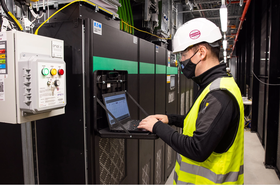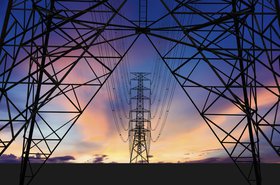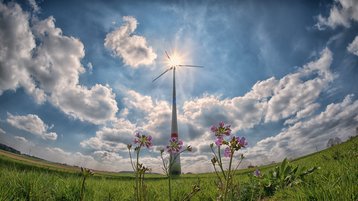Data centers are central to almost everything we do. Managing the transport we rely on, enabling the supply chains that keep our supermarkets stocked, and communicating with our colleagues and loved ones. All is being made simpler, faster and more efficient by data-center connectivity. And, as the last year has demonstrated, date centers are robust in even the most challenging of circumstances.
The increasing amount of work being done in data centers also places more urgency on developing new ways to make data centers more energy efficient and an asset to the grids on which they rely. In 2018, the magazine Nature reported that data centers and the networks associated with them may lead to information and communications technology (ICT) requiring 21 percent of our total electricity production by 2030.
While data center-based solutions may often be more energy-efficient than the processes they replace, this growth is still a problem in the context of our urgent need to decarbonize power production in order to meet climate targets. As a result, there is an ongoing global effort to make data centers greener, doing more work with fewer emissions.
Other studies estimate that the ICT industry will consume just eight percent of total supply by 2030. At this level, it becomes possible to foresee a world where digital energy demand can be met entirely by renewables.
This is the ambition of many ICT companies, and the investments being made in renewable energy and supporting technologies are supported by industry-leading environmental and sustainability targets.
The challenge of renewables
Renewable energy sources bring green electrical energy, but they also bring other issues and engineering challenges. While some renewable energy sources offer predictable production (hydro), we are in fact moving towards a grid dominated by wind and solar. By nature, these variable renewable energy (VRE) sources fluctuate in their output.
It’s easy to see how this leads to potential problems. An electrical grid system must constantly match consumption with electricity production. This is fundamental to grid and frequency stability. But if VRE has fluctuating output, periods of over- and under-supply seem inevitable.
Grid operators are developing ways to manage that potential mismatch. But consumers can do more than consume. Their on-site electrical systems, especially their back-up power systems, can actually help in grid stabilization and therefore in the successful adoption of renewables. This help comes in the form of ancillary services that can be delivered ‘back’ to the grid operator.
Rethinking the data center
On the one hand, we have an increasingly digitalized world requiring more and more power. On the other, we are seeing an enthusiastic uptake of renewable energy, which, if we are to maintain that momentum, will require innovations in how we maintain security of supply.
When thinking about how to build this future, it’s important to remember that these are not independent problems, and that the changes we’re heading towards can be more than a replacement of existing systems. As we transform power systems and digitalize everything from manufacturing to healthcare, we have an opportunity to not just keep the lights on, but to rethink everything about how these essential services work.
Data centers, of course, cannot afford power instability: by necessity, they must be ‘always-on’ to support critical services powering governments, life and safety services, financial institutions and more. To ensure continuous power, data centers are outfitted with uninterruptible power supplies (UPSs) – sophisticated battery systems and back-up generators that step-in to keep everything running when the grid supply fails.
UPSs need to respond instantly to changes in supply, deliver large amounts of power, and do so with the utmost reliability. In other words, the qualities they need in order to support stable data center operation also make them perfect for providing ancillary services to the grid, such as quickly stepping on or off the grid or feeding in energy. These fast actions can stabilize a grid and contain grid frequency.
Making this a reality requires some work: a data center UPS will need to be aware of how the grid is operating, while the grid will need to be ready to receive supply from data centers as well as deliver power to them. Demonstrating that this is possible, and building the systems to make it work, is the topic of our new white paper, in which Microsoft and Eaton have collaborated to show how data centers can support the grid through real-world testing.
A UPS at Eaton’s headquarters in Dublin, for example, is now successfully providing fast frequency response services to the local grid by reducing the building’s demand when grid frequency drops.
This is a complete rethink of the role of power consumers on the grid. Before, electricity transmission was a one-way street from production to consumption; now, we are seeing how it can be bidirectional and interactive. While before, a system like a UPS was an operational necessity and a necessary expense, now we are seeing how it can be a source of revenue when ancillary services are sold back to the grid operator.
As for data centers, we are seeing how their centrality to modern life is about more than just digital services. As they begin supporting the renewable energy grid, we may start to see them not just as data centers, but as energy centers helping to decarbonise electricity and creating a digital and sustainable future for all.
If you would like to discover more about our EnergyAware technology and the opportunities for data centers, take a look at the additional information available below:
More...
-

Microsoft teams up with Eaton for 'grid-interactive' UPS at Dublin data center
As Ireland grows increasingly hostile to data centers due to grid concerns
-

Sponsored From data center to energy center
The role of data centers in supporting renewable power adoption
-

Sustainability goals are huge: How will the European data center market meet them?
What Eaton thinks is the solution to a sustainable and stable grid


